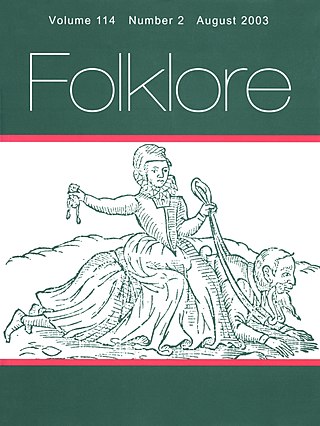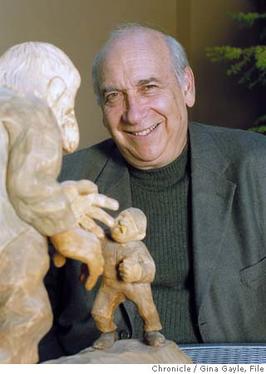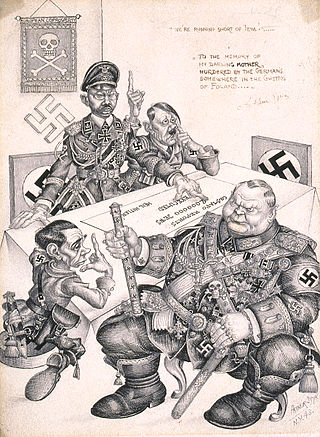Related Research Articles

Folklore is the body of expressive culture shared by a particular group of people, culture or subculture. This includes oral traditions such as tales, myths, legends, proverbs, poems, jokes, and other oral traditions. This also includes material culture, such as traditional building styles common to the group. Folklore also encompasses customary lore, taking actions for folk beliefs, and the forms and rituals of celebrations such as Christmas, weddings, folk dances, and initiation rites.

A lightbulb joke is a joke cycle that asks how many people of a certain group are needed to change, replace, or screw in a light bulb. Generally, the punch line answer highlights a stereotype of the target group. There are numerous versions of the lightbulb joke satirizing a wide range of cultures, beliefs, and occupations.

Jumping the broom is a phrase and custom relating to a wedding ceremony in which the couple jumps over a broom. It is most widespread among African Americans and Black Canadians, popularized during the 1970s by the novel and miniseries Roots, and originated in mid-19th-century antebellum slavery in the United States. The custom is also attested in Irish weddings.

A joke is a display of humour in which words are used within a specific and well-defined narrative structure to make people laugh and is usually not meant to be interpreted literally. It usually takes the form of a story, often with dialogue, and ends in a punch line, whereby the humorous element of the story is revealed; this can be done using a pun or other type of word play, irony or sarcasm, logical incompatibility, hyperbole, or other means. Linguist Robert Hetzron offers the definition:
A joke is a short humorous piece of oral literature in which the funniness culminates in the final sentence, called the punchline… In fact, the main condition is that the tension should reach its highest level at the very end. No continuation relieving the tension should be added. As for its being "oral," it is true that jokes may appear printed, but when further transferred, there is no obligation to reproduce the text verbatim, as in the case of poetry.
The Dozens is a game played between two contestants in which the participants insult each other until one of them gives up. Common in African-American communities, the Dozens is almost exclusively played in front of an audience, who encourage the participants to reply with increasingly severe insults in order to heighten the tension and consequently make the contest more interesting to watch.

Stand-up comedy is a form of comedy performance directed to a live audience, where the performer stands on a stage and delivers humorous and satirical monologues sometimes incorporating physical acts. These performances are typically composed of rehearsed scripts but often include varying degrees of live crowd interaction. Stand-up comedy consists of one-liners, stories, observations, or shticks that can employ props, music, impressions, magic tricks, or ventriloquism.

Folklore studies is the branch of anthropology devoted to the study of folklore. This term, along with its synonyms, gained currency in the 1950s to distinguish the academic study of traditional culture from the folklore artifacts themselves. It became established as a field across both Europe and North America, coordinating with Volkskunde (German), folkeminner (Norwegian), and folkminnen (Swedish), among others.

Self-referential humor, also known as self-reflexive humor, self-aware humor, or meta humor, is a type of comedic expression that—either directed toward some other subject, or openly directed toward itself—is self-referential in some way, intentionally alluding to the very person who is expressing the humor in a comedic fashion, or to some specific aspect of that same comedic expression. Here, meta is used to describe that the joke explicitly talks about other jokes, a usage similar to the words metadata, metatheatrics and metafiction. Self-referential humor expressed discreetly and surrealistically is a form of bathos. In general, self-referential humor often uses hypocrisy, oxymoron, or paradox to create a contradictory or otherwise absurd situation that is humorous to the audience.

Alan Dundes was an American folklorist. He spent much of his career as a professional academic at the University of California, Berkeley and published his ideas in a wide range of books and articles.
The Aarne–Thompson–Uther Index is a catalogue of folktale types used in folklore studies. The ATU Index is the product of a series of revisions and expansions by an international group of scholars: originally composed in German by Finnish folklorist Antti Aarne (1910), the index was translated into English, revised, and expanded by American folklorist Stith Thompson, and later further revised and expanded by German folklorist Hans-Jörg Uther (2004). The ATU Index, along with Thompson's Motif-Index of Folk-Literature (1932)—with which it is used in tandem—is an essential tool for folklorists.
An elephant joke is a joke cycle, almost always an absurd riddle or conundrum and often a sequence of such, that involves an elephant. Elephant jokes were a fad in the 1960s, with many people constructing large numbers of them according to a set formula. Sometimes they involve parodies or puns.
Viola jokes are jokes that are directed towards violas and viola players, thought to have originated in the 18th century. Violas at the time were mainly used for relatively easy parts and as accompaniment, rather than as solo instruments; violists were generally low-paid and of lower social standing.

Baby is a musical with a book by Sybille Pearson, based on a story developed with Susan Yankowitz, music by David Shire, and lyrics by Richard Maltby Jr. It concerns the reactions of three couples each expecting a child. The musical first ran on Broadway from 1983 to 1984.
The Baby Train, or simply Baby Train, is an urban legend told in the United States, United Kingdom and Australia. The legend first appeared in Christopher Morley's 1939 novel Kitty Foyle. According to the legend, a certain small town had an unusually high birth rate. This was allegedly caused by a freight train passing through the town and blowing its whistle, waking up all the residents. Since it was too late to go back to sleep and too early to get up, couples would have sex. This resulted in a mini-baby boom.
Traditional stories, or stories about traditions, differ from both fiction and nonfiction in that the importance of transmitting the story's worldview is generally understood to transcend an immediate need to establish its categorization as imaginary or factual. In the academic circles of literature, religion, history, and anthropology, categories of traditional story are important terminology to identify and interpret stories more precisely. Some stories belong in multiple categories and some stories do not fit into any category.
"Do Your Ears Hang Low?" is a children's novelty song often sung in schools and at camps. The melody of this song is usually a shorter version of "Turkey in the Straw", but it can also be sung to the tune of the "Sailor's Hornpipe". It has a Roud Folk Song Index number of 15472.
Wind-up doll jokes is a series of jokes in which an imagined wind-up doll of a well known person acts in a way supposedly peculiar to this person. An example is given in the biography of Miles Davis by John Szwed. Miles had a habit to walk to the back of the band after finishing his solo, which was called "turning his back on the audience" by press. George Crater of the Down Beat magazine cracked the following joke: "Question: What does a Miles Davis doll do if you wind it up? - Answer: It turns its back on you!" A possible explanation of the appearance of this kind of jokes is that dolls of celebrities have long been part of American culture.
The Motif-Index of Folk-Literature is a six volume catalogue of motifs, granular elements of folklore, composed by American folklorist Stith Thompson. Often referred to as Thompson's motif-index, the catalogue has been extensively used in folklore studies, where folklorists commonly use it in tandem with the Aarne–Thompson–Uther Index (ATU), an index used for folktale type analysis.
Cruel jokes is a joke cycle dealing with cruelty and macabre topics. They belong to the category of sick humor. Typical examples:

There are several major aspects of humor related to the Holocaust: humor of the Jews in Nazi Germany and in Nazi concentration and extermination camps, a specific kind of "gallows humor"; German humor on the subject during the Nazi era; the appropriateness of this kind of off-color humor in modern times; modern anti-Semitic sick humor.
References
- 1 2 Alan Dundes (July 1979). "The Dead Baby Joke Cycle". Western Folklore. 38 (3): 145–157. doi:10.2307/1499238. JSTOR 1499238. PMID 11633558.
- ↑ "Jokes are a serious, 'psychic' business", San Francisco Examiner
- ↑ "That's Not Funny - That's Sick // Folklorist Alan Dundes looks at the serious side of sick jokes". St. Petersburg Times. 2 December 1987.
- ↑ Bronner, Simon J. (1988). American Children's Folklore . august house. pp. 127. ISBN 9780874830682.
- ↑ McWhorter, Diane (Spring 1977). "An Ugly Joke: "Dead Babies" // Dead Babies by Martin Amis". The North American Review. 262 (1). University of Northern Iowa. JSTOR 25117878.
- 1 2 3 4 5 6 Warner, Andrew (2008). P.S. Dead Baby Jokes Aren't Funny: The Grotesque in Sick Humor (M.A.). Truman State University.